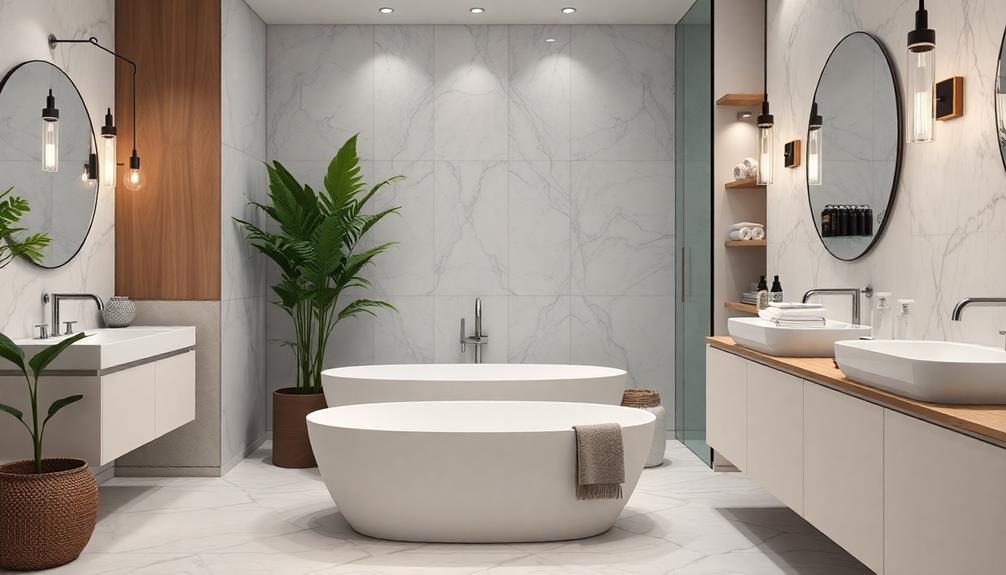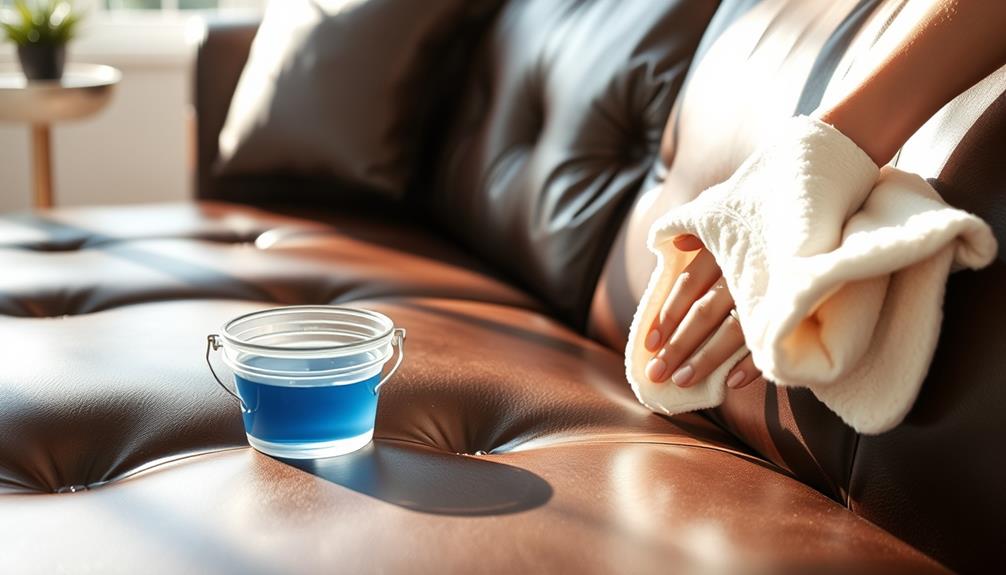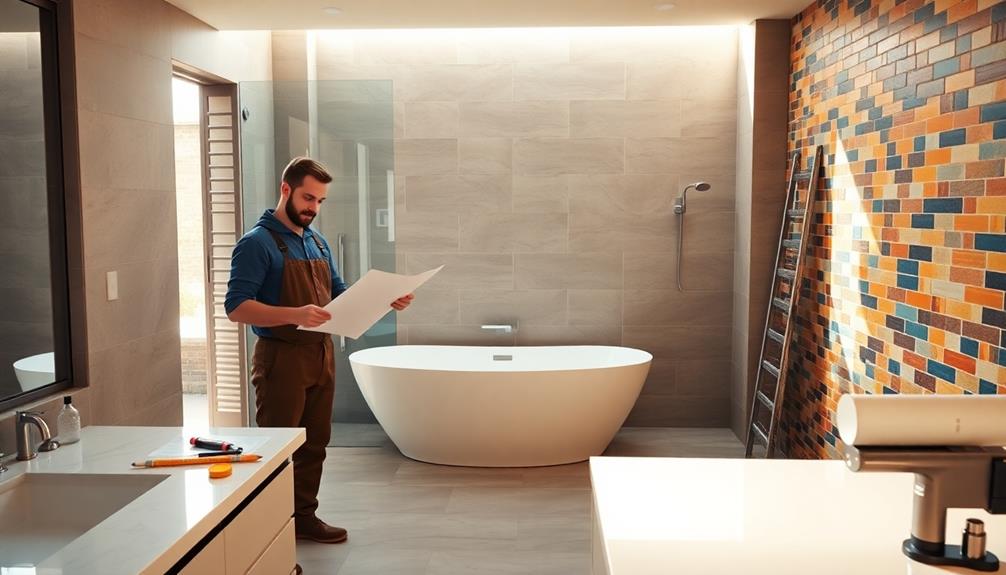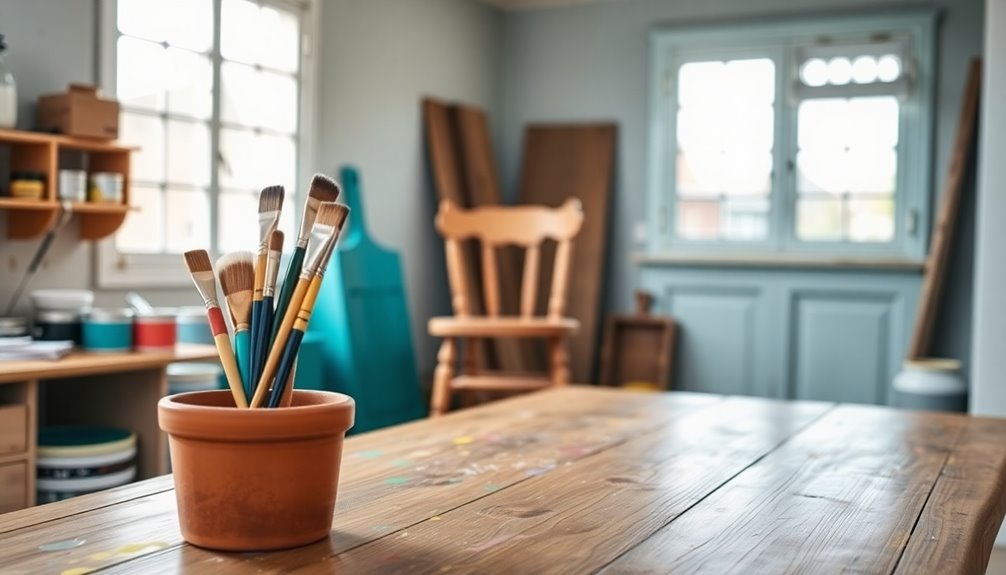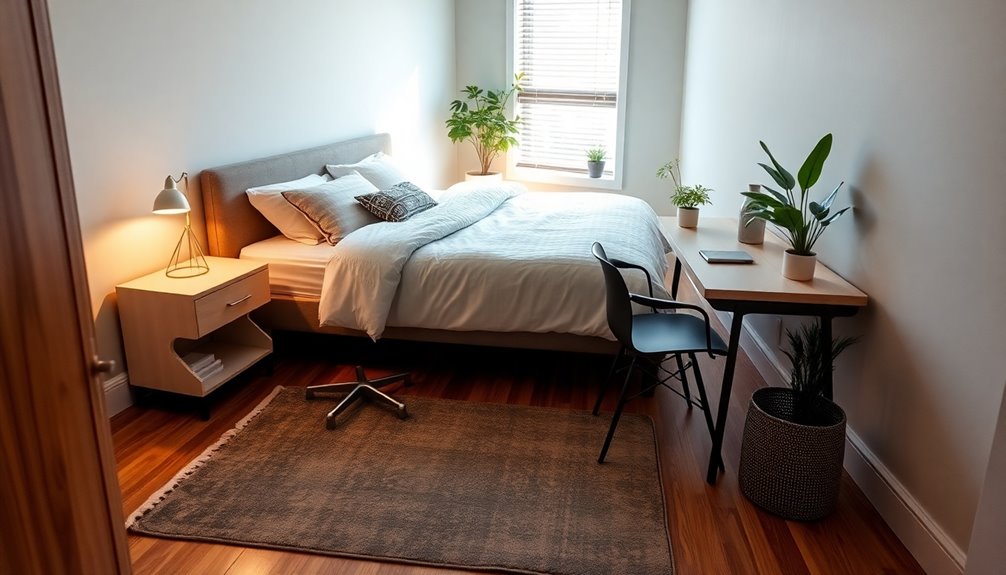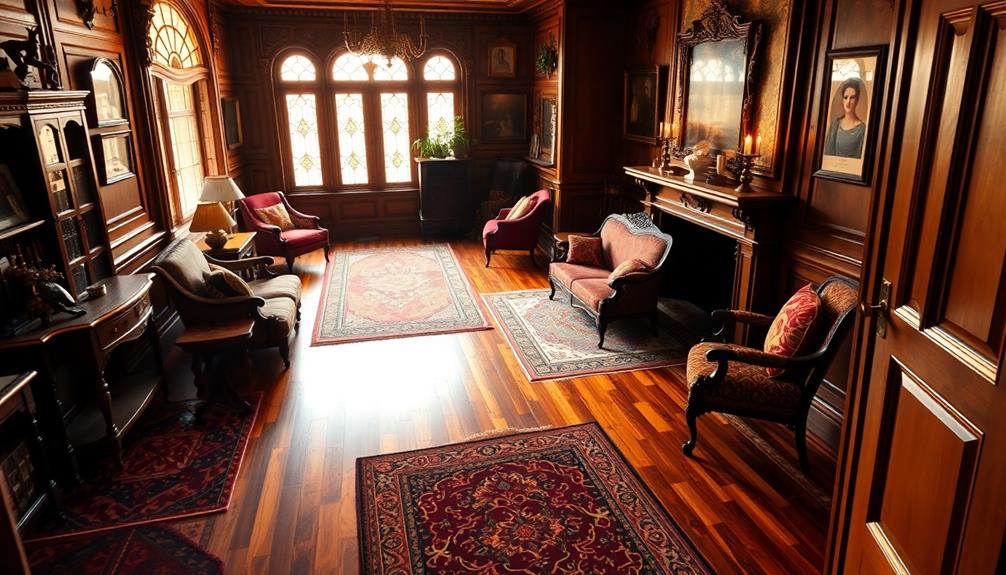To renovate your bathroom, you should begin by assessing the layout to ensure efficiency and establishing a practical budget, which is typically around $12,000 in the United States. Then, seek advice from a contractor regarding plumbing and electrical requirements. Prepare the area by removing fixtures and turning off water and electricity. Choose tiles suitable for walls and floors, apply a waterproof membrane, and ensure correct installation. Opt for materials that are resistant to moisture and select stylish fixtures that align with your design concept. Lastly, add personal touches such as paint, decorations, and plants to create a soothing ambiance. Explore more tips to assist you smoothly through your project.
Key Takeaways
- Assess your current bathroom layout and establish a clear budget before starting the remodel.
- Consult with a general contractor to address plumbing and electrical requirements.
- Carefully plan the demolition process and inspect for any water damage or mold.
- Choose suitable tiles, fixtures, and materials that prioritize moisture resistance and functionality.
- Personalize the space with decor, smart devices, and calming elements like plants and essential oils.
Planning Your Bathroom Remodel
When planning your bathroom remodel, have you considered how the current layout impacts your daily routine? Evaluating your existing space is vital. Identifying any necessary layout adjustments, like relocating fixtures to enhance functionality, will make your bathroom more efficient for your needs.
Additionally, it's wise to establish a budget plan that outlines all potential costs, as this can prevent overspending and help you stay on track.
Next, create a detailed budget. Remember, the average bathroom remodel in the U.S. can cost around $112,000, so account for all materials and labor costs, along with potential unexpected expenses. Consulting a general contractor can help guarantee your design ideas work within the existing plumbing and electrical frameworks, especially for heavy installations like soaking tubs.
Sketch your ideal bathroom design, incorporating desired amenities and layout adjustments. Use these visuals to communicate effectively with your contractors and suppliers.
Don't forget to research local suppliers to explore competitive pricing and materials that fit your vision. Check out DIY guides for additional resources that can make your home improvement project smoother.
Demolition and Preparation Steps
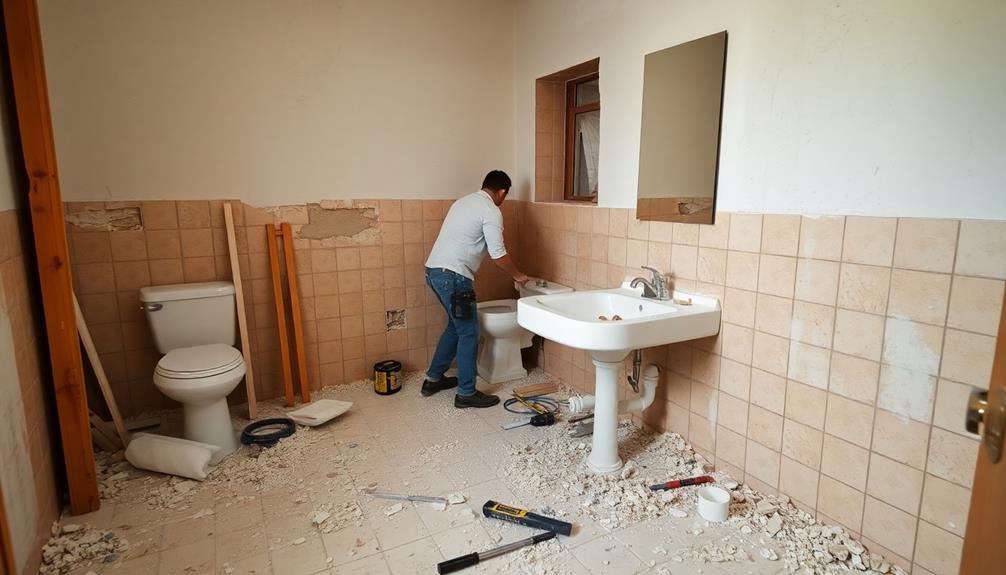
With your plans in place, it's time to tackle the demolition and preparation steps. Start by removing all accessories and non-fixed objects from your bathroom.
Before you engage in demolition, turn off the electricity at the main breaker box and shut off the water supply. This prevents any leaks during your renovation. Additionally, consider enhancing your home security during the remodel process, as homes without security systems are 300% more likely to be burglarized (Value of Home Security Systems).
Next, carefully identify and remove existing fixtures like the toilet and sink. If you're removing the toilet, make sure to plug the waste pipes and be cautious around load-bearing walls.
While you're at it, inspect the area for any signs of water damage or mold, as these may require additional repairs before moving forward.
Once you've cleared the space, verify that all plumbing and electrical work is completed before laying new flooring or installing fixtures. This is vital for maintaining an efficient workflow and keeping your project on schedule.
Remember to wear proper safety gear, including masks, gloves, and goggles, to protect yourself from dust, debris, and potential hazards throughout the process. Preparing this way sets a solid foundation for your bathroom remodel.
Tiling and Installation Process
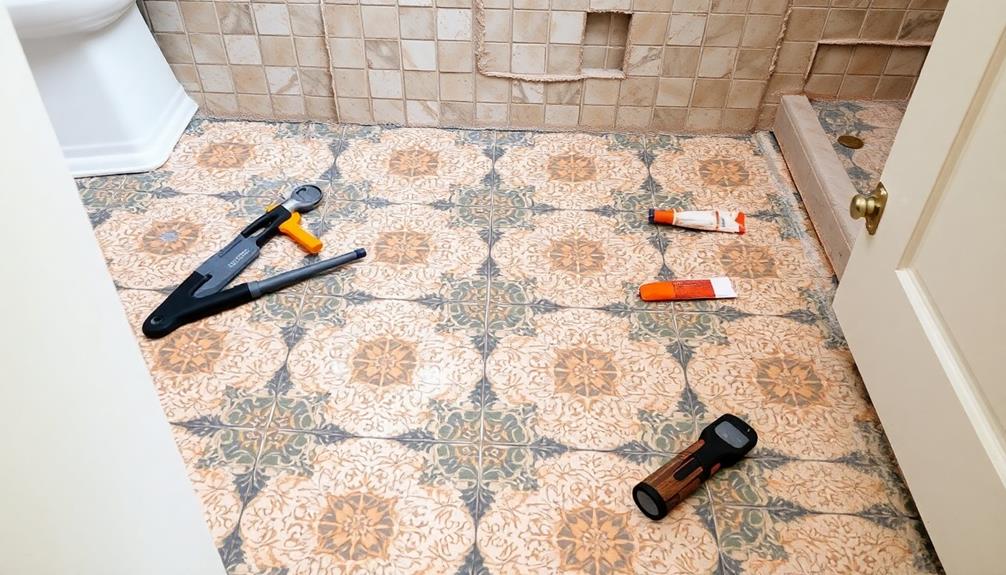
Now that you've prepared the space, it's time to plunge into the tiling and installation process. Start by selecting the right tiles: smaller tiles work best for the shower floor to accommodate drainage, while larger wall tiles create a seamless look.
Consider integrating a Dual-Flush Toilet System for water efficiency, which is ideal for homes aiming to conserve resources.
Follow these steps for a successful installation:
- Waterproofing: Apply a RedGard waterproofing membrane on wall tiles in wet areas. This protects against moisture and mold growth.
- Mixing Thin-Set Mortar: Combine thin-set mortar to a consistent, smooth texture. Apply quickly for effective tile adhesion.
- Tiling: Lay your wall tiles using the mixed mortar, guaranteeing even spacing. Place smaller tiles on the shower floor, keeping drainage in mind.
- Grouting: Once the tiles are set, fill gaps with grout. Choose a color that complements your design for a polished appearance.
After tiling, conduct final inspections to verify everything meets building codes and your design expectations. This step is essential before sealing the project.
With these tips in mind, you'll achieve a beautiful, functional bathroom remodel.
Finishes and Amenities Selection
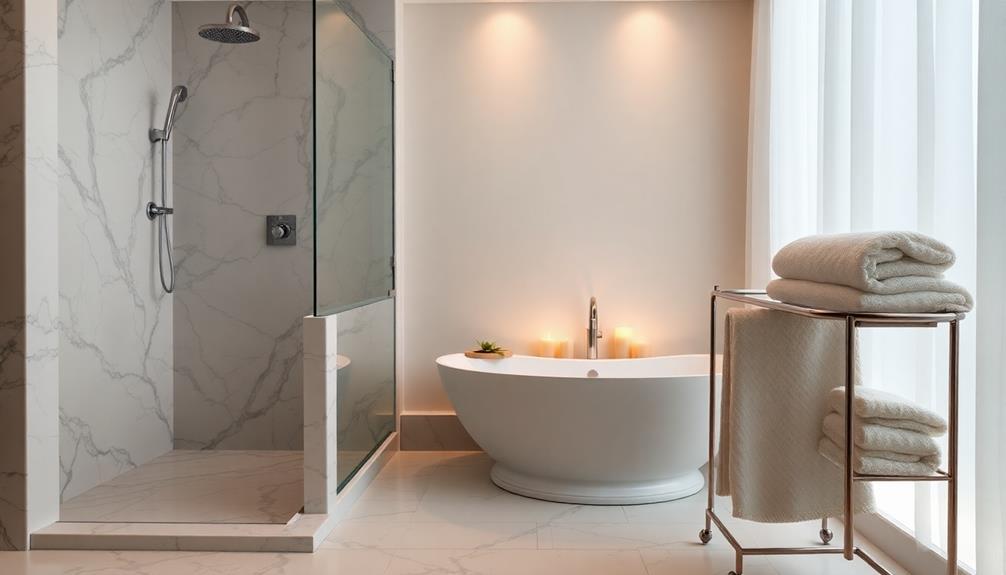
Selecting finishes and amenities for your bathroom remodel is essential for both functionality and aesthetics. Start by prioritizing moisture-resistant materials, like tiles with a low water absorption rate, and choose paint specifically formulated for high-humidity areas to prevent mold and mildew growth.
Incorporating elements from interior design basics can further enhance your selection process, ensuring that your choices meld beauty with practicality. Incorporating elements such as color theory, furniture arrangement, and lighting can truly transform a space and create a harmonious environment that is both visually appealing and functional. Furthermore, considering biophilic design in mental wellness can bring the benefits of natural elements into the interior, promoting a sense of calm and connection with the environment. By blending these design elements, you can create a space that not only looks great but also contributes to the well-being of the individuals who inhabit it.
Consider your bathroom's size when choosing fixtures. Larger spaces can accommodate double vanities or soaking tubs, while smaller bathrooms may benefit from a small vanity and compact fixtures to optimize space.
Explore various countertop materials, such as quartz or granite, ensuring they complement your cohesive design. Pay close attention to high-quality hardware for your bathroom fixtures, as these details not only enhance visual appeal but also contribute to the overall functionality and longevity of your remodel.
Incorporate effective lighting elements and decor pieces, like mirrors and decorative shelving, that reflect your design vision while providing practical solutions for everyday use.
Final Touches and Personalization
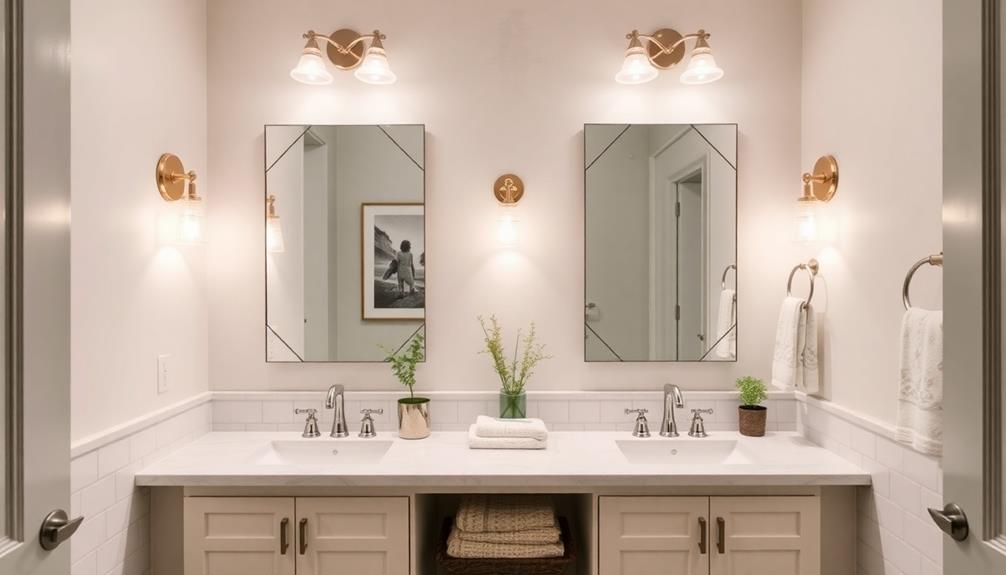
Your bathroom's final touches and personalization make all the difference in transforming it into a space that feels uniquely yours.
After completing all major installations, it's time to focus on the details that enhance both functionality and aesthetics. Reflect on incorporating essential oils for a calming atmosphere to create a spa-like experience in your bathroom.
Here are some key elements to reflect on:
- Paint Samples: Pick up paint samples from big box retailers to find the perfect color that aligns with your design theme. A fresh coat of paint guarantees a clean finish without the need for touch-ups later.
- Smart Devices: Incorporate smart devices like smart mirrors or lighting. These not only add modern flair but also improve the functionality of your space.
- Decor Items: Choose decor items, such as rugs, mirrors, and new fixtures that complement your cohesive aesthetic. They help create a welcoming environment.
- Living Plants: Add a touch of nature with living plants that thrive in low-light conditions. They serve as a revitalizing focal point and enhance the overall ambiance.
Frequently Asked Questions
What Is the Correct Order to Remodel a Bathroom?
To remodel a bathroom, start by removing fixtures and ensuring utilities are off. Then, address plumbing and electrical needs, install drywall, waterproof, lay tiles, and finish with vanity and decor for a cohesive look. Hiring a bathroom remodel contractor can make the process much smoother, as they will have the expertise to handle all aspects of the renovation. A professional contractor can also provide valuable advice on design, material selection, and layout to ensure the best results for your space. With their skillset and experience, a bathroom remodel contractor can transform your outdated bathroom into a stunning and functional retreat.
Can I Renovate My Bathroom Myself?
Absolutely, you can renovate your bathroom yourself! Imagine transforming your space into a personal oasis. With careful planning, the right skills, and online resources, you'll create a stunning retreat that reflects your style and vision.
Can I Renovate My Bathroom for ?
Yes, you can renovate your bathroom for $5,000. Focus on high-impact changes like updating fixtures and paint. Consider DIY tasks to save money, but budget for unexpected costs and hire professionals for complex work.
How Much Should You Spend on a Bathroom Remodel?
You should spend around 5-10% of your home's value on a bathroom remodel. For smaller projects, consider a budget of $5,000 to $15,000, but always set aside funds for unexpected costs.
Conclusion
In the end, your bathroom remodel is more than just tiles and fixtures; it's a reflection of your style and a sanctuary for relaxation. As you step back to admire your hard work, notice how the chaos of demolition contrasts with the serenity of your finished space. You've transformed not just a room, but your daily routine, turning mundane moments into personal retreats. Embrace this blend of function and beauty—it's your oasis, crafted by your vision.
